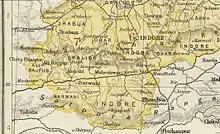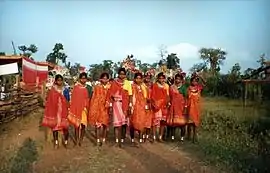Jhabua State
Jhabua State was one of the princely states of India during the period of the British Raj. It had its capital in Jhabua town. Most of the territory of the princely state was inhabited by the Bhil people, who constituted a majority of the population. The revenue of the state in 1901 was Rs.1,10,000.[1]
| Jhabua State | |||||||||
|---|---|---|---|---|---|---|---|---|---|
| Princely State of British India | |||||||||
| 1584–1948 | |||||||||
 Flag
 Coat of arms
| |||||||||
 Jhabua State in the Imperial Gazetteer of India | |||||||||
| Capital | Jhabua | ||||||||
| Area | |||||||||
• 1901 | 3,460 km2 (1,340 sq mi) | ||||||||
| Population | |||||||||
• 1901 | 80,889 | ||||||||
| History | |||||||||
• Established | 1584 | ||||||||
| 1948 | |||||||||
| |||||||||

History
The state of Jhabua was founded by Kesho Das or Kishan Das, in 1584. He was granted the title of Raja by Mughal Emperor Akbar as a reward for a successful campaign in Bengal, and for punishing the Bhil Chiefs of Jhabua, who had murdered the wife and daughters of the Imperial Viceroy of Gujarat. In 1724 Jhabua was captured by Udaji Pawar and was under him till 1726.[2] Jhabua was later given to the Holkars of Indore, however the Holkar Maharaja restored the ruling dynasty and allowed them to rule the mountainous and woody areas, and the right to collect a fourth of the revenue from the districts that were directly conquered by the Holkars. There were 20 families of rank in the state who paid £1500 to the Holkars and £2500 to their own chief. In 1875 the state had a population of 55,000 and a revenue of £22,500.[3]
During British rule the state was under the Bhopawar Agency[4] of the Central India Agency and in 1927 it became part of the Malwa Agency. After India's independence in 1947, Jhabua's last ruler signed the accession to the Indian Union on 15 June 1948, and Jhabua became part of the newly created Madhya Bharat state, which in 1956 was merged into Madhya Pradesh.[5]
Rulers
The rulers of Jhabua were Rathor Rajputs. They had the title of H.H. Raja Saheb. They were granted a hereditary salute of 11 guns by the British.[6]
- Rajas
| 1584 – 1607 | Kesho Das | |
| 1607 – 1610 | Karan Singh | |
| 1610 – 1677 | Man Singh | |
| 1677 – 1723 | Kushal Singh | |
| 1723 – 1727 | Anup Singh | |
| 1727 – 1758 | Sheo Singh | (d. 1758) |
| 1758 – 1770 | Bahadur Singh | |
| 1770 – 1821 | Bhim Singh | (d. 1829) |
| 1821 – 1832 | Pratap Singh | (d. 1832) |
| 1832 – 1840 | Ratan Singh | (d. 1840) |
| Nov 1841 – 1895 | Gopal Singh | (b. 1841 – d. 1895) |
| 26 Apr 1895 – 1942 | Udai Singh | (b. 1875 – d. af.1945) |
| 1942 – 15 Aug 1947 | Dhalip Singh | (b. 1905 – d. 1965) |
References
- https://dsal.uchicago.edu/reference/gazetteer/pager.html?objectid=DS405.1.I34_V08_153.gif
- Malwa in Transition Or a Century of Anarchy: The First Phase, 1698-1765, published in 1993
- https://books.google.co.in/books?id=14kIAAAAQAAJ&pg=PA67&dq=jhabua+imperial+gazetteer&hl=en&sa=X&ved=0ahUKEwiDgJXFvq3oAhUOdysKHTMVASAQ6AEIJjAA#v=onepage&q=jhabua%20imperial%20gazetteer&f=false
- Chisholm, Hugh, ed. (1911). . Encyclopædia Britannica. 15 (11th ed.). Cambridge University Press. p. 411.
- Jhabua - Princely State
- https://dsal.uchicago.edu/reference/gazetteer/pager.html?objectid=DS405.1.I34_V08_153.gif